#sauchi art
Explore tagged Tumblr posts
Text

Using for the first time my custom star halftones (just made them today lol)
#zero escape vlr#zero escape fanart#zero escape luna#vlr luna#virtues last reward#zero escape#zero escape virtue's last reward#sauchi art
157 notes
·
View notes
Photo

I am obsessed with this commission 😍 I was given a lot f freedom and asked only for an oil bottle, so I enjoyed every moment of making this! 🌜💙 if you are interested in this bottle or want something similar then send m a wee message 😚✌️ #instaart #art #glassart #acrylicpainting #oilbottle #forsale #moonart #vegetableoil #cookingaccessories #art #scottishartist #artforsale #bottleart #scotlandartists #scotlandartistoninstagram (at Sauchie) https://www.instagram.com/p/CQTfUsxhEyK/?utm_medium=tumblr
#instaart#art#glassart#acrylicpainting#oilbottle#forsale#moonart#vegetableoil#cookingaccessories#scottishartist#artforsale#bottleart#scotlandartists#scotlandartistoninstagram
1 note
·
View note
Text
Most of the online population window-shops Wikipedia for their information, but if you happen to be interested in psi (or any anomalous phenomena), its accounting of facts and history can be outrageously selective revisionism. The entries would be laughable if their writers weren’t so blatantly dishonest.
Anyone who’s spent time researching psi on Wikipedia can discern in seconds the editors’ bias in favor of anydebunking explanation. Look up pretty much any paranormal subject and you’ll find the same pattern: an insultingly cursory outline of the anomaly, followed by sometimes ludicrous “explanations” that demonstrate the editor(s) did virtually no work in investigating the original reports and probably nutshelled what little information is presented only from books written by pseudoskeptics—who themselves have cherry-picked aspects of the cases to bolster their perspective.
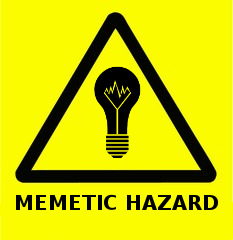
The trashing of a particular phenomenon or character assassination of a psi-talented individual very often revolves around a core of “celebrity” debunkers associated with the Committee for Skeptical Investigation (CSI)[1] such as Joe Nickell, Martin Gardner, Susan Blackmore, Elizabeth Loftus, James Alcock, and Paul Kurtz. When an appeal to authority is needed, there will often be offered a quote from superstars Carl Sagan (despite Sagan’s professed openness to investigating telepathy and reincarnation), Michael Shermer, Alcock, or the “Amazing” Randi to snark upon the poor, “deluded,” and long-dead psi researchers of yestercentury and today.
Of these debunking sources, only a few are genuine scientists—and even a fewer number than that are still active in CSI. Bill Nye isn’t a scientist. The Amusing Randi isn’t a scientist. In fact, in the early years a group of “hard” scientist members bailed on the organization because of its dogmatic, anti-scientific attitude.[2]
Meanwhile, the number of academically credentialed paranormal investigators increases by the day.
In addressing the thousands of psi studies and the meta-analyses of these studies, references to “methodological faults” come up quite often—conveniently footnoted to articles by Joe Nickell, Martin Gardner, James Alcock, or even the non-scientist Randi. How wide-ranging in sources! As Craig Weiler points out:
“Since alternative sciences are mostly shut out from mainstream consideration, the evidence isn’t examined closely in many mainstream scientific discussions. In other words, there are very, very few solid scientific sources for skeptics to work with. There are no sources that sufficiently support statements about parapsychology or many other frontier science such as “this is pseudoscience” “rejected by the scientific community” or “negatively impacts the public understanding of science.” No one has ever gone to the trouble to try to prove these things scientifically. And it’s very doubtful that it’s even possible.
So skeptics have to resort a lot of the time to sources that are created “in house” so to speak. These come in the form of skeptics being interviewed, skeptical articles, newsletters, blogs by notable skeptics, etc. This is especially true on Wikipedia when it comes to psychics. It is very tough to make the case that any of them are frauds or deluded without resorting to opinion or (the failure of James Randi Foundation’s) Million Dollar Challenge. (To award a psychic for genuine psi abilities). Mainstream sources generally stay away from landing on one side or the other of this debate because of either liability issues or fear of losing audience by being too skeptical.
This is undoubtedly why the Guerrilla Skeptics work so closely with CSI and JREF. Without the sourcing from these two reactionary organizations or their fellows and other skeptical organizations, many of their assertions would be just about impossible to make.”
Further, the rebuttals by the original psi investigators to these criticisms—who often clearly enumerate the mistakes, mischaracterizations, or outright falsehoods made by these pseudoskeptics—are never mentioned in the Wikipedia entries.
The use of this small core debunking crowd as final authorities is akin to having the Wikipedia entries for Impressionist movement and artists referencing a core of ten or so Impressionist-hating critics, when there in fact have been thousands of art critics.
Again, the references and “further reading” sections at the articles’ ends rarely contain the primary references/reports on the phenomena or the work of paranormal researchers. It’s inevitably debunking books or articles you’ll find…Almost as if they want to short-circuit your interest; as if they don’t want you to do independent research and make up your own mind.
Thus, Rule 1: Try to avoid reference primary sources, that is, the lengthy investigations by the persons who initially researched and often witnessed the anomalous activity. Always reference only the debunking material, or the opinion of some member of CSI. You’ll know this is so if the book referenced is published by Prometheus Books, the house organ of CSI.[3]
I don’t have any problem with giving skeptical, non-paranormal explanations the primary place in an article—if the explanations offered were honest and credible in the mechanical-physical specifics of their explanations—but Wikipedia entries don’t exhibit this equality, because the debunkers’ explanations usually don’t.
That’s because there is a “mafia” of pseudoskeptics controlling the editing process of Wikipedia entries on anything paranormal. CSI and Guerrilla Skeptics have pages devoted to how one should debunk anything they deem “non-science,” both in real life and in online contexts.[4]
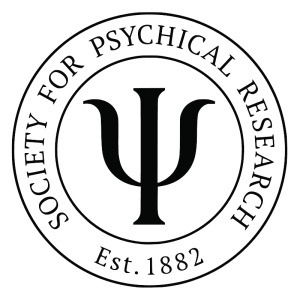
First, the “RationalWiki” (the pseudoskeptic’s safe space) entry covering the Society for Psychical Research is a shambles. The Guerilla Skeptics unfairly downplays the first generation of SPR. Richard Hodgson, Edmund Gurney, Henry and Nora Sidgwick, Frank Podmore, and (on the American side) William James all busted dozens upon dozens of fraudulent mediums. Hodgson exposed Theosophy founder Madame Blavatsky of several types of imposture in 1885. Podmore worked on collating the accounts contained in Hodgson and Myers’s massive Phantasms of the Living (1886) yet himself remained unconvinced of mediumship and postmortem survival (he concluded telepathy was probably responsible for mediums’ “hits”). But Podmore didn’t stop trying to find the evidence. William James revealed many spiritualist seances as conjuring feats (which alienated the original Spiritualist contingent within the ASPR into rejecting that organization, ironically, as a bunch of debunkers). The wiki entry doesn’t mention the SPR’s in-depth and failed attempts to disprove the mediumship of Leonora Piper.
Yet the Guerillas reveal little to none of these facts in their trite account—because these Victorian searchers professed and applied what the mafia don’t practice: a skeptical yet open-minded commitment to discovering the truth. Truth cannot be “absolutely settled” in science—that is what makes it unique in human intellectual history. As William James said, “Science means, first of all, a certain dispassionate method. To suppose that it means a certain set of results that one should pin one’s faith upon and hug forever is sadly to mistake its genius and degrade the scientific body to the status of a cult.”
This is the deeper truth about the role of science the Guerilla Skeptics cannot bear to face, but was foundational to the SPR pioneers, because the latter were philosophers and philologists and lawyers unburdened with a worship of a materialism that can be as corrosively dogmatic as Baptist literalism.

Next, take the subject of poltergeists. The Wiki mafia editors are very selective as to which cases to debunk by granting them a dedicated page. The Amityville, Enfield, and Borley Rectory cases get the longest Wiki pages by far—and they were deemed fraudulent by investigators from the Society for Psychical Research as well as the committed debunkers.[5]On the SPR’s investigation of poltergeists, the wiki prominently mentions Lambert’s discredited hypothesis that the phenomenon was caused wholesale by underground seismic or liquid vibrations and weather factors. This conjecture was soundly disproven by the SPR’s Alan Gauld and Tony Cornell.[6] Is Gauld and Cornell’s scientific experimentation to prove or disprove Lambert’s hypothesis even mentioned? No.
The Wiki entry for the well-documented 1967 Rosenheim poltergeist is a particularly decrepit specimen of attempted ledgermain. There are no mentions of the 1967 Tropication Arts poltergeist in Miami (exhaustively investigated as it occurred by Roll and Pratt), the Stratford, Connecticut poltergeist of 1850 (witnessed by thousands of persons over seven months, detailed in diary form by Rev. Eliakim Phelps, owner of the house, and investigated by skeptical scientists, journalists, and clergy who came away convinced the phenomenon was paranormal), or the Sauchie, Scotland poltergeist of 1960 (investigated by A.R. Owen and witnessed by a clergyman, three medical doctors, and a teacher). These three cases are conspicuous absences in the Wiki data, due either to their impeccable documentation or, relatedly, the fact that no close to credible debunking explanations exist by the “experts.”
Rule 2: Always highly emphasize the crudely-produced frauds, then tar the entire phenomenon with these selected instances—and try not to use the debunking work of genuine skeptics who busted the frauds, such as SPR investigators Frank Podmore, Henry Sidgwick, William James, Nora Sidgwick, Alan Gauld, Richard Hodgson, or E. J. Dingwall. Mentioning their work only gives them respectability, and no dispassionate psi investigator should ever be tolerated in a Wikipedia article on the subject.
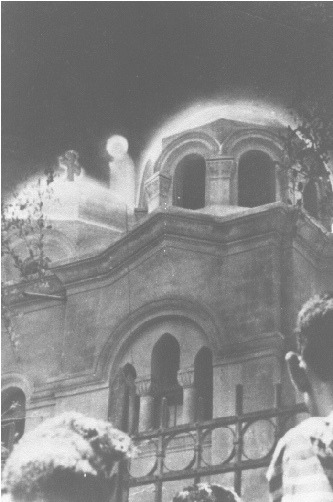
The 1967 Zeitoun, Egypt Marian apparition entry is apparently a fluke in that the descriptive entry about it is surprisingly longer and more detailed than the “mass hysteria” explanation made by the skeptics further down the page (meaning: we have no idea how so many people could see and even photographed repeatedly an identical apparition, therefore here’s an unproved accounting for it)…Which brings us to the core of their mindset: they often suggest “natural” explanations that beggar belief in their convoluted, pseudoscientific chutzpah.
According to these “rational” authorities, multiple witnesses to apparitions like Zeitoun can be primed to suffer simultaneous and identical hallucinations of Mother Mary, levitating bedsheets, candlesticks, and even phantom people, the lack of scientific/psychological evidence for “group hallucinations” be damned…The mafia would prefer us to believe women mediums merely fake trances during which they surreptitiously manipulate unseen but necessarily present “concealed ropes” that can pull 50-pound bureaus a foot and a half across the floor and back again in seconds…And did you know that 10-year-olds can easily fool professional magicians and a dozen trained observers during a poltergeist outbreak? And that these kids obviously place dozens of stones into their houses’ walls to disgorge themselves by means of invisible networks of threads (that are never found)—and then float across rooms and land with no contact sound?
These are remarkable feats for untrained, pre-adolescent conjurers—many of whom had never actually seen a stage magic act in their life.
Rule 3: Use anything within the realms of standard, cause-and-effect Newtonian physics, psychology, cognitive science, or sociology, even if unproven, obsolete, or just plain pseudoscience (like “mass hysteria”), to explain away the phenomenon in an ad hoc manner.
We’ll take a look at mediums. The Wiki editors’ bias is most easily demonstrated by the amount of page space given over to the rationalizations which always outweigh the compressed anecdotes on the mediums’ feats (the latter which, a curious individual’s further scrutiny will find, are told through often highly detailed accounts that what was experienced clearly violates physics as we know it).
Again, the entries for individual mediums such as Leonora Piper all consist of very short summaries (or outright omission) of the prodigious examples of their talents and the laborious screening-out processes for fraud undertaken by investigators. The debunking “explanations” amount to a hand-wave mention of “conjuring tricks” and one of two instances of witnessed fraud meant to negate the psi they exhibited.
A jury would inevitably find the grounds of these debunkings as weak hearsay compared to the oft-mountains of evidence in favor of the abilities’ existence. Thus
Rule 4: Always refer to case studies as sets of anecdotes or anecdotal. This is supposed to insulate them entirely from consideration as evidence, and it applies doubly to case studies of the careers of individual psychics or trance mediums; in this case, one can then proceed to Wikifraud! them further and attack the person as a charlatan. As in Rule 2, if one instance of anything ambiguously fraudulent is found in a medium’s career—in other words, an anecdote of fraud—raise this one anecdote to the status of unimpeachable truth and tar the person’s entire career with fraud, despite any contrary evidence from investigators and reliable witnesses. This is an example of the double-standard fallacy many pseudoskeptics use. Fraud discovered=true fact; Psi demonstration that is far beyond what chance would predict= “non-evidential.”
SHORT CUTS:
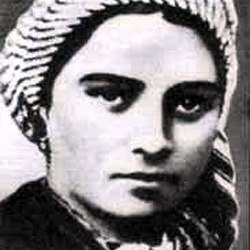
Lourdes: In 1858, 14 year-old Bernadette Soubirous spoke with a “white lady” at an ancient grotto in southern France. The apparition told her to dig in the ground near the cave and Bernadette did, causing a spring to appear whose waters have become a potable shrine to millions. Both the Vatican and independent medical authorities have verified 69 medically inexplicable healings.
The Wiki response: the placebo effect, natch…But have the debunkers any clue how an idea or a suggestion in the mind can induce the near-instantaneous healing of fractured bones, cancer-eaten tissue, or blindness (all medically documented)? Nope. No one does. Move along. It seems the editor stopped short. The less said about this one the better.
vicka 011.jpg The six young visionaries having an apparition in 1981 L to R: Vicka Ivankovic, Jakov Colo, Mirjana Dragicevic, Ivanka Ivankovic, Marija Pavolic, Ivan Dragicevic Medjugorje Early apparition Chris Rogers Mobile:+447808913186 Skype: chris.johnrogers http://www.blackandwhitetv.net
Fátima & Medjugorje: Well, there are no Guerilla Skeptic interpolations in the Fatima entry at all—no section on possible alternate explanations, nothing but a sentence offering possible “retinal effects” due to looking at the sky near the sun, natural meteorological optical effects, or the “suggestibility” of the huge (30-50,000) crowd during the “Miracle of the Sun” on October 13, 1917. Apparently, even a Guerilla Skeptic doesn’t (or rather, isn’t allowed to) mess with canonical Catholic beliefs.
The papal blessing on Fatiman Lucia Santos as a saint and the authentication of the mass visions probably explains the different treatment the mafia offers in the Medjugorje entry (and the fact that it occurred 51 years closer to the present, 1971, when we should know better about these things, right?). The Medjugorje visions were never given Roman official seal of authenticity, nor were the young women involved ever canonized. Open season, then! In the skeptic section, there are two references by Joe Nickell, one to a CSI’s Skeptical Inquirer magazine article, and a skeptical weighing-in by Pope Francis.
The difference in treatment between the Fatima and Medjugorje events is striking. One wonders if the mafia would have been given a hands-off if the Bosnian events had been recognized as genuine and the primary “seers” beatified or even canonized.

Padre Pio: Like Saint Lucia Santos, Saint Pio of Pietrelcina has been canonized, so there’s minimal interference by the mafia. As far as the accounts of his stigmata go: The skeptic attempt to use an ad hoc that Pio bought carbolic acid to fake the wounds is immediately countered by the admission that Pio and his monastery brother Paolinopurchased the chemical to sterilize needles for Spanish Flu immunizations. No evidence at all is offered that the stigmata could have been caused by the acid.
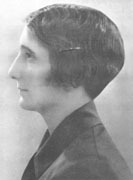
Geraldine Cummins: The entry on automatic writing medium Geraldine Cummins actually quotes psychical researcher Harry Price, of all people, as debunking her voluminous writings as “products of her subconscious.” Now go over to Wikipedia’s Harry Price page to see how his character and career fare as a whole in the mafia’s eyes; they do not note the many times he credulously boosted his “star” psychics. The man was very protective of his test subjects. Using Price’s opinion of Cummins in the entry is blatant cherry-picking, in other words. Cummins herself is on record as being skeptical of her own channeling’s sources, which is in fact mentioned in passing in the “reception” entry. Then go to other sources on Harry Price’s career as a psi researcher and you’ll find a firm believer in the anomalous abilities, but only when it suited him. He was, if nothing else, a promoter for the abilities of Harry Price.
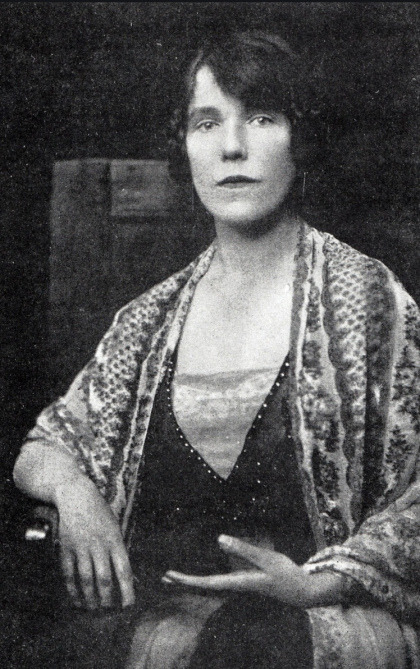
Gladys Osborne Leonard: The Gladys Osborne Leonard entry goes into no detail whatsoever about the many spontaneous “hits” the trance medium Leonard/her control “Feda” made that neither Leonard nor her sitters could possibly have known—because they were proxy sitters two (or sometimes three) times removed from the actual questioner.[7] How could Leonard have known who the real sitters’ identities were asking the questions? It would seem impossible, yet “Feda” was accurate in names, times, descriptions, and life-events of these thrice-removed sitters more than half the time. If fraud is ruled out (and on testimony of the SPR investigators, who had Leonard trailed by detectives, she was of impeccable character vouched for by all her friends) the only alternative for the mafia is telepathy or even super-psi—but they can never use those explanations, of course…So the mafia cites only attempts at explanation from skeptics wielding the usual techniques (fishing, cold reading, fraud). Explaining away “Feda” as a “second personality” of Leonard’s, as some of the referenced skeptics do, explains nothing, for this second personality apparently was either telepathically gifted or in fact a disincarnate intelligence.
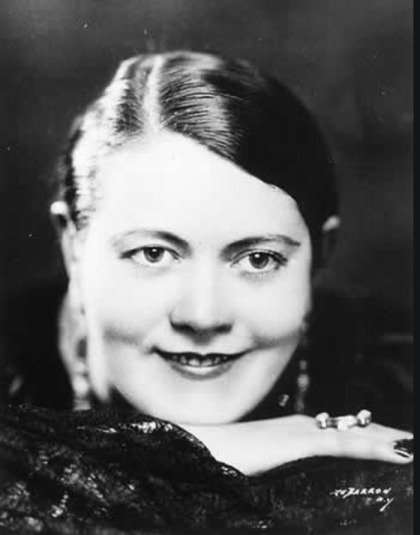
Eileen Garrett: Trance medium Eileen Garrett was more curious about and flummoxed by the source of her abilities than perhaps any other medium, and tried for decades to understand it, enlisting psychologists, psychiatrists, and scientists. Of all people, the wiki entry on her clairvoyance uses the opinion of parapsychology’s worst fraud-perpetrator Samuel Soal to dismiss her ability to replicate J.B. Rhine’s experimental successes with him, Soal. Thus—
Rule 2b: anyone’s opinion is apparently permitted, as long as it debunks with extreme prejudice, and
Rule 2c: researchers who believe(d) in the existence one type of paranormal phenomena are occasionally 100% okay to use as sources of authority as long as they are debunking another paranormal phenomenon.
In the Garrett wiki writer’s case this is ironic, in that Soal was known to be deeply envious of Rhine’s experimental work and, when could not replicate his famous telepathy studies, Soal produced them fraudulently by altering score cards.
In 1930, Garrett was “spontaneously contacted” by the consciousness of Herbert Irwin, captain of the R101 airship that had crashed two days before, killing Irwin and 47 others.
CSI house organ Prometheus Books’ two authors John Booth and Melvin Harris both get ample quotes from their books explaining the results of her R101 sittings by not explaining them at all as fraudulent, trivial, non-evidential. No rebuttals by direct witnesses or other parapsychologists are permitted; the “final word” by Booth and Harris is she was a fraud.
DEEP DIVES:
I’m going to take four examples of Wikipedia’s blindered approach and look at them in-depth.
Stefan Ossowiecki
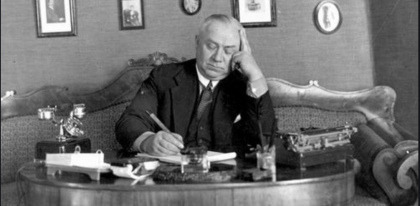
Polish industrialist and remote-viewer/psychometrist Stefan Ossowiecki was nationally famous in Europe for his ability to not only read multiply-sealed letters but often tell the investigator what occurred while the letter was written (the writer’s gender, age, appearance, health condition, describe the room or house where it was composed, etc.) His “hits” at reading the contents of envelopes far outweighed his misses, and there is no way short of “hot reading” (extensive detective work done on the target material beforehand) that he could have known about the writers’ lives—but in many cases neither Ossowiecki nor even the investigator knew they would be performing an experiment on the spur-of-the-moment. Many times, someone Ossowiecki did not know (a Parisian, say) who had written a letter that was given to someone else and then given at the last moment to the investigator to test him. How could he possibly have known what was written (or drawn) in the letter? He would then not only describe what was written or drawn inside, but spontaneously describe the writer. Furthermore, he several times told the investigator personal details about the writer and the people through whom the letter passed to his hand, who he also didn’t personally know, or even had an idea existed.
This led researchers Charles Richet, Gustav Geley, and Eugene Osty to conclude Ossowiecki was a not only a “superpsi”-level clairvoyant (remote viewer) but an astounding psychometrist: by touching the envelopes, he could see into the past and somehow watch the person write the note/drawing, and sense the scene.
For this one, the Wiki editors roll out psychologist C.E.M. Hansel for the inevitable “conjuring trick” claim with no further elaboration, then hit us with this: “Psychologist E. F. O’Doherty wrote that the clairvoyance experiments with Ossowiecki were not scientific.”[8] This is a strictly true criticism; but still, triple-blinded tests of the man’s ability while he is being closely watched by the experimenters for fraud (dozens upon dozens of times) makes for compelling anecdotes that he possessed an extraordinary talent.
The editors’ omission of the preparations the investigators made to test Ossowiecki is a refusal to wrestle with the details, as is usually the case in their entries. It serves to demonstrate their bedrock faiththat there is literally no possible test debunkers would call scientific with regard to psi abilities. Which is exactly their intended program: it doesn’t exist, simply because it can’t, therefore there is no way to test it.
Leonora Piper
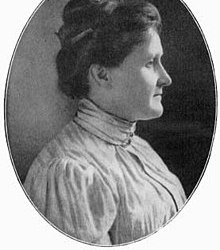
In the first stub, we have Mrs. Piper characterized as a cold reader, a fisher for information, and muscle reader. None of the authors cited for these statements sat with Leonora for a reading, nor did they interview any of the persons who did; it appears they simply came to the subject with these explanations based upon the SPR reports. With complete disingenuousness, it ignores the fact that A/SPR members William James, Richard Hodgson, Frederic Myers, James Hyslop, and Oliver Lodge conducted strenuous measures against cold reading, hot reading, and muscle reading. These trained philosophers and scientists weren’t stupid and gullible as the pseudoskeptics would like you to think. Richard Hodgson was so flummoxed by her abilities that he hired private detectives to secretly trail Mrs. Piper and her family for several months, watching them for meetings with “cut-outs” between their friends and the SPR who might be feeding her any information (the “hot reading”). They turned up absolutely no evidence of fraud, which impressed Hodgson and the other investigators. Over the years Hodgson continued to periodically monitor as closely as he could Piper’s social activities but again came up with no evidence at all for hot reading. They even paid for she and her daughters to travel to England for strenuous examination by the British SPR and use dozens of random strangers as sitters, where there was no possibility of her gaining a hot reading.
These facts go conveniently unmentioned anywhere in the article.
While it is true that Mrs. Piper often had the sitters hold her hands or place their hands against her forehead, which could open her to charges of muscle reading in gauging how close her answers were, the quality of double or triple-blinded information she on occasion gave—ostensibly evidential of either spirit communication or omniclairvoyance (superpsi)—would lead one to think that even if she did use muscle reading, it was irrelevant to her results, because the information would have to have been conveyed via unconscious telepathy by the sitters themselves to Mrs. Piper; even the sitters were often unaware of the information she provided, which was found later by them to be true.
This is a possibility the Wiki editors never consider. And she did fish, but the sitters were for the most part told to remain silent and poker-faced as her controls sought for names, dates, or concepts.
The biography section says she “made a fortune” from her readings. It doesn’t make clear that this money was paid to her by the SPR to keep her exclusively their subject, with an investigator and stenographer/note-taker present at every sitting. She was essentially a salaried test subject for some 15 years.
Two examples of Piper’s sittings amongst many serve to demonstrate what sort of inexplicable talent they found themselves compelled to explain:
For a period of several years, Mrs. Piper’s main “spirit control” was the coarse-speaking French physician “Phinuit.” A man named John Hart had a sitting with Leonora which was suddenly interrupted by the “spirit” of George Pellew, (GP), who was a recently deceased friend of Hodgson and Hart both whom Piper did not know about. GP successfully spelled out his name for the two surprised men (Hodgson sat in on the sessions most of the time). Pellew, speaking through Phinuit, described a specific pair of shoes he was wearing that had been originally given to Hart by Pellew’s parents (a true past event). This of course would count towards nothing but possible telepathy. GP then asked Hart to get in touch with Pellew’s friends Jim and Mary Howard to have a sitting with Mrs. Piper, and described a specific conversation on metaphysics he once had with the Howards’ 15 year-old daughter Katharine—another event that turned out to have occurred (but neither Hodgson nor Hart knew about at the time). GP mentioned a specific book he had failed to finish reading when he died which Hodgson knew to be true.
The Howards then came in for a sitting (pseudonymously, at Hodgson’s ever-skeptical insistence). This time GP communicated directly, bypassing Phinuit. GP corrected Jim Howard’s wayward assertion that a mutual friend (Rogers) was writing a novel by telling him that Rogers was actually working on a memorial to him, GP. This was correct. GP described Rogers’s deceased daughter as being nearby (that is, “on the other side”) as she still fretted over her condition during her final days, in which she had to be fed with a tube. GP then mentioned “Berwick” and “Orenberg,” more friends of the Howards. Mrs. Piper knew of none of these persons, and all the information and connections given were true.
At their next sitting the Howards brought their daughter Katharine. GP joked about her terrible violin playing, to which Mrs. Howard took offense but Katharine later clarified was a running joke between she and GP—his spirit was apparently attempting to establish “bona fides” with the teenager. Mrs. Piper passed out of trance then back in as Phinuit returned and carried on a conversation in French with Katharine, which the girl knew fluently from living in France. Mrs. Piper consciously knew no French.
The GP control apparently exhibited either remote viewing (clairvoyance) or “retroactive” telepathy on one occasion. With the Howards at home, Hodgson asked GP to visit their house and give a report on what he perceived. Mrs. Howard was writing letters to GP’s mother and someone named Tyson. GP also perceived her holding one of his own books as she wondered if his spirit were around her at that moment. When Hodgson checked with Mrs. Howard he discovered that the events as seen were true but had occurred on the previous day. Hodgson conjectured that Mrs. Piper was either retroactively remote viewed the past or telepathically accessed Mrs. Howard’s mind in real time as she thought of the previous day’s activities. Either way, this is a possible astounding feat of superpsi.[9]
Next, Sir Oliver Lodge wanted to eliminate the possibility of telepathy in Piper’s sittings. So he in effect double-blinded himself by means of an object gotten from an elderly uncle he with whom he was not close. It was a gold watch owned originally by the uncle’s twin brother, who had died decades ago. Lodge handed it to Mrs. Piper, whose control immediately declared it was once owned by the physicist’s uncle. The control, Phinuit, said that this uncle was very fond of another uncle whose name was Robert—another hit; it was true, the living uncle’s name was Robert. Her voice then changed from Phinuit’s to the dead twin, who called himself Jerry (third hit).
Lodge then asked for something only Jerry and Robert would know between them. Phinuit spoke of the two nearly drowning in a dangerous creek while young, killing a cat in “Smith’s field” with a rifle, and that Jerry treasured a “skin” that he’d found. Robert, it turned out, still possessed his brother’s beloved snakeskin, and they did swim in a perilous creek.
This wasn’t enough for Lodge, so he wrote to his younger uncle asking for any memories involving a creek and a cat in the twins’ youth. The third uncle recalled it all: the dangerous creek and the poor cat they shot in the field. They were so mortified of their behavior they’d all kept it secret, but it got out, to their shame.
Despite the true statements around the pocket watch—handed to Piper with no contextual information at all about it—Lodge still insisted on sending detectives to the town where his three uncles grew up to find out if recent enquiries had been made about the family. The detectives reported back: no, and not even any evidence that the shameful activities of the brothers long ago had been documented in public records in any way.[10]
These are two examples of Piper’s mediumship, and there several more of equal power, which we need not go into—and the Guerilla Skeptics would really prefer you didn’t. You might catch curiosity that there’s something to these strange things.
The Wiki entry on Piper emphasizes repeatedly the disagreements between members of the A/SPR over the nature of her talent, as if their clashes in toto negate her authenticity, when in fact James, Hyslop, and even skeptic Frank Podmore simply favored a belief that it was due to telepathy—but even this professional consensus on a paranormal explanation is a no-no that the Wikivigilantes cannot dare mention.
Out of thousands of quotes that could’ve be chosen to characterize the ever-cautious Hodgson’s strenuous work with Piper, we are offered Morton Prince’s observation that her mediumship “wrecked his mind” after Hodgson began to favor the spirit hypothesis over telepathy. In the editors’ selective reading, Frank Podmore is said to have concluded that “Hyslop’s séance sittings with Piper ‘do not obviously call for any supernormal explanation’ and ‘I cannot point to a single instance in which a precise and unambiguous piece of information has been furnished of a kind which could not have proceeded from the medium’s own mind, working upon the materials provided and the hints let drop by the sitter.’”[11]
Podmore’s is an incredibly poor assessment of the evidence, as the Howards and Lodge episodes above reveal; both sittings exhibited precise and unambiguous pieces of information that could not have proceeded only from Mrs. Piper’s mind. According to Ghost Hunters author Deborah Blum, Podmore concluded that “…Leonora Piper was a woman with some telepathic skills and an excellent memory for facts shared casually by her sitters. He had no proof of the latter…but her overall record, although impressive, failed to convince…Perhaps this was too cynical, Podmore allowed: ‘The accurate appreciation of evidence of this kind is almost an impossible task,’ (Podmore) wrote in his book Modern Spiritualism. ‘Mrs. Piper would be a much more convincing apparition if she could have come to us out of the blue, instead of trailing behind her a nebulous ancestry of magnetic somnambules, witchridden children, and ecstatic nuns.’[12] (emphasis added)
To be clear: There was no proof at all for her possessing “an excellent memory for facts shared by her sitters” that in turn fooled investigators. This says it all as far as using Podmore as a credible source on Leonora Piper. Again, the Guerilla squad makes no mention of his ambivalent conclusion on telepathy. And his lumping her together with the hundreds of fraudulent “show” mediums is insulting.
After a cherry-picked tally of her failures and sprinklings of dismissive evaluations in her bio and career, were given a lengthy “skeptical reception” section. As if it were needed.
Few of her many hundreds of “hits” are mentioned. When Piper accurately described the recently deceased daughter of a Reverend Sutton to he and his wife during an 1893 sitting, then gave her cause of death, her nickname and the nicknames of the girl’s brother and sister, “ John G. Taylor suggested that the information Piper gave could naturally be explained if she had read an obituary notice in the local newspaper. Taylor also suggested Piper may have picked up clues from the sitters about the girl’s nickname.” (emphasis added)
Read that closely again. There is no proof here, just “what ifs,” nor any evidence of how Piper could have gleaned clues from the grieving Suttons to declare specific information.
Her “miss” rate was openly acknowledged by James, Hodgson, Hyslop, and others as a problem. The nuanced (yet unfalsifiable) explanation for this is that a person in trance would have difficulty gaining any instantly coherent information from a “widened” or “higher” source while in an unconscious state. As Piper’s own controls explained the problem, the deceased individual to whom the sitter wishes to speak sometimes has to have their own control “on the other side,” and it becomes extremely difficult to convey information across three barriers to the living.
This gross equivocation, even if it were entirely false, still doesn’t explain her consistent hit rate. Podmore and James tended to believe Mrs. Piper had very strong secondary personalities, but as James and Myers would point out, these personalities, emanations of the Subliminal Self as Myers called it, can do impossible things.
DANIEL DUNGLAS HOME
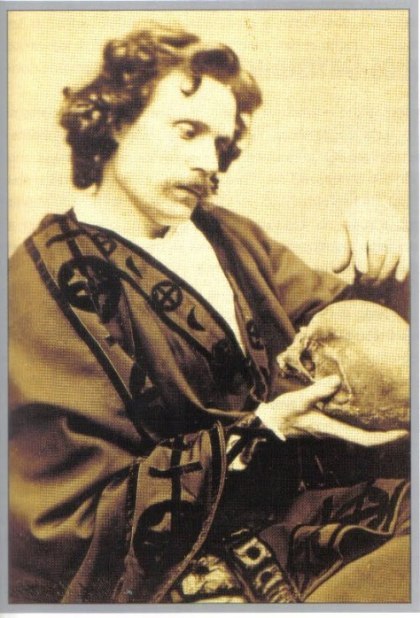
Home gets much Wiki debunkery upside his head simply because his feats were witnessed by many hundreds of people, including scientists, skeptics, and heads of state and, it’s been claimed, that “every attempt to bust him as a fraud failed.” No soup for you.
Quote from the page:
Gordon Stein has noted that “While the statement that Home was never caught in fraud has been made many times, it simply is not true… It is simply that Home was never publicly exposed in fraud. Privately, he was caught in fraud several times. In addition, there are natural explanations both possible and likely for each of his phenomena.”
Does the page give specific examples of Home being busted by any individuals? Nope. Here, Michael Prescott goes into James Randi’s attempted dismissal of Home with regard to Sir William Crookes’s thorough investigations of him, and Randi’s devious (yes, devious) “revisions”:
https://michaelprescott.typepad.com/michael_prescotts_blog/2015/10/blast-from-the-past-under-the-table.html
The Wikibunkers explain away the most spectacular Home levitation, wherein he allegedly floated out a three-story window and back in another, as their wide brush to tar his other levitations.
And their story goes like this: the feat was done in near-darkness, and Home could have been standing on those four-inch ledges outside the window…Therefore he did stand on those ledges. Nothing more to it! Here’s another gem:
“Science historian Sherrie Lynne Lyons has stated that a possible explanation for Home’s alleged levitation phenomena was revealed in the twentieth century by Clarence E. Willard (1882–1962). Willard revealed his technique in 1958 to members of the Society of American Magicians. He demonstrated how he could add two inches to his height by stretching. According to Lyons “it is quite likely that [Home] used a similar technique to the one that Willard used decades later.”
Two inches? One problem with that: Home was witnessed levitating three to five feet off the ground during his trips, by at least a dozen people.
And again: “Historian Simon During has suggested the levitation of Home was a magic trick, influenced by Robert-Houdin.”
Do they take the time going into During’s specific details (if he even had them) of exactly how this was accomplished by Home or Robert-Houdin?
Nope. Didn’t think he would. It’s a trade secret. And Houdini never replicated any of Home’s feats.
INDRIDI INDRIDASON
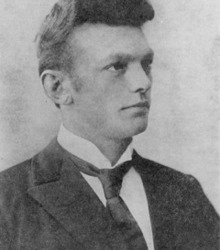
So weak. Perhaps the lamest debunking attempt of all Wikiskeptic antics.
Prior to Indridason, a “simple farm boy,” there were no spiritualists let alone physical mediums in Iceland.[13] The 22-year-old happened to be asked to sit in on a séance in early 1905 and immediately produced tremors and rattling in the table before which they sat. It is noted that Indridi had never before seen a conjuring act, which were extremely rare in the country.[14]
The first psychical research society in Iceland was set up in 1905 to study Indridason and kept him on retainer, much like the SPR paid Leonora Piper as a subject for 17 years. Most of his manifestations occurred while he was in a trance. They included multiple direct voices, wind gusts, instrument playing, the levitation of objects and the medium himself, light phenomena of various types, materialization, rappings, and, most bizarrely, the dematerialization of his arm. These events were witnessed at times by upwards of 80 persons in the “experimental house” space, specially constructed by the psychical society, in which he lived from 1906 to 1909.[15] In this space, Indridason was usually held by investigators or strapped down in a chair that sat behind a wire mesh-barrier that could be examined for signs of tampering during his sessions. Some of these manifestations took place in plain light.
Indridason’s primary control, at first, was his paternal grand-uncle Konrad Gislason. While in trance he was repeatedly tested with needle pokes to no reaction, as if in a depicted hypnotic state. In November 1905, four persons testified that tables levitated as high as 7 feet several times during Indridi’s trance. All attempts to pull them down failed. It also occurred spontaneously while he was in a full waking state. A seance on November 24, 1905 was interrupted at roughly 9pm by a personality named “Emil Jensen,” a “manufacturer,” who spoke of a fire burning at that moment in a Copenhagen factory. It was brought under control within an hour. Three accounts of this particular séance were written down, one of them immediate, but many more people were present.[16]
The next issues of the leading Danish newspaper Politiken were delivered to the island four weeks later, at Christmas, 1905, and “Jensen’s” declarations had been true: a large fire at a lamp and chandelier factory in Copenhagen had occurred on the late night of November 24. Of the four fires that had occurred in Copenhagen within a month’s period, this was the only to befall a factory. There were no telephones or even telegraph service between Iceland and Denmark. In 2009, researcher Erlendur Haraldsson searched Copenhagen’s city records and found a manufacturer and coffee merchant Thomas Emil Jensen who had lived two doors down from the burnt lamp factory and had died at 50 in 1898; on further research it was discovered that the man had lived his entire life within two blocks of the site of the fire.[17]
In December 1907 to early 1908, an interloping spirit named Jon Einarsson caused very destructive poltergeist activity while Indridi was both in and out of trance, but was pacified somehow by a group of “ministering” spirits who insulated Indridi from Jon’s anger by anointing the medium’s forehead. Afterward Jon became a primary control. Two other “spirits” controlled Indridason: a Spanish-French opera diva (possibly Maria Felicia Malibran) who often sang from within the room, and a Norwegian doctor who later was tentatively identified as leprosy expert Daniel Cornelius Danielssen.
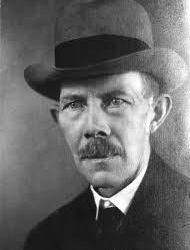
In late 1908, Dr. Gudmundur Hannesson became involved. Hannesson was a professor of medicine at the University of Iceland, an anthropologist, a Reykjavik city councilman, an honorary member of the Icelandic and Danish Association of Physicians, and served as President of the University of Iceland for two terms. This was no woo-woo guy and he was determined to debunk Indridi’s exhibitions, which were causing uproars in the press (Indridason had become the most famous person in Iceland).
Hannesson witnessed the near full array of Indridason’s talents—apart from levitation, which occurred a few times but in darkness. To confound the possibility of Indridi or an accomplice moving objects outside the mesh barrier, he placed newfangled glow-in-the-dark tape on the musical instruments and objects about the room. He saw a zither fly about high as the ceiling and dart at incredible speeds as it played snatches of tunes whose acoustics followed the location of the instrument at every second. He heard two disembodied voices, an accomplished female singer and a low male voice sing a duet in harmony, separated in space by eight to ten feet from one another in the hall with only five people (and no women) present at the seance. Many separate voices had been already witnessed in the surrounding space of the hall by hundreds of seance-goers over the years. With this personal witness Hannesson completely ruled out ventriloquism, which was a consistent charge leveled against the medium by skeptics (nearly all of whom had never attended one of Indridi’s seances).
While the Wiki summary of his career is unusually detailed and even-handed, all of the further “rational criticism” is just opinions at second and third hand and beyond, mostly from the contemporary Icelandic press (who were incredibly hostile towards him for religious reasons) with not a single eyewitness account in the lot. The remainder are tired pseudoskeptical takes on what possibly could have accounted for the events: the usual ventriloquism, conjuring tricks, confidence schemes amongst his assistants. This is utterly disingenuous, for the firsthand witnesses and Indridi’s assistants were of high standing. A quote by an Antonio da Silva Mello claims the sittings weren’t “scientific.” For this, as mentioned above, Indridason was the first trance medium in Iceland’s history; the country had no formal “parapsychology labs,” nor were they aware of the SPR’s protocols for testing mediums. In any case, Dr. Hannesson’s strict settings for testing Indridason were very close to those used by the SPR: Indridi was physically restrained and isolated by thick mesh netting from the areas where the majority of the PK activity took place. The experimental house was thoroughly examined three times before each seance and one successful seance took place at Dr. Hannesson’s own house in a room he chose at the last moment.
EPISTEMOLOGY
The psi of the laboratory and psi of the medium are obviously of different character. Lab telepathy has been shown to exist but is weak-to-moderate in effect…But quantifying the likelihood of someone like Mrs Piper correctly guessingthousands of items about the sitters present before her, or about the proxy sitters substituting for them, and evidential facts about the deceased surely beats the lab numbers by several orders of magnitude beyond chance.
In short, telepathy, superpsi, and survival communication are three entirely different things, although the mechanism by which they utilize the brain may be similar or even the same, as elusive as it presently is.
By the 1930s, the medium of information delivery for the existence of psi largely changed from individual case studies to laboratory reports—and that wasn’t enough for the mainstream scientists to pick up the ball. Even design protocols for psi experiments that would garner little to no criticism if new pharma drugs were their subject are claimed by pseudoskeptics to be compromised by “file drawer problems,” “selective reporting,” and “confirmation biases.”
These are bullshit wavings-away of evidence. Facts are adduced indirectly in science all the time, and their existence is assumed to hold until more firm evidence backs up the experimental assays. And this is certainly the case with forms of psi. It has been indirectly proven; that is, what is displayed in thousands of lab experiments, after all confounding factors are eliminated, calls for the most parsimonious explanation: that a form of anomalous cognition that entirely bypasses the physical senses exists. This may be called evidence type 2.
Debunkers ask for direct evidence (evidence type 1, as is displayed by a physics or chemistry experiment) and think poorly of non-supportive of indirect evidence (evidence 2). I suppose the only acceptable direct evidence is…well, as I’ve pointed out above, the pseudoskeptics have consistently moved the goalpost for at least a century and a half, so I suppose we can’t expect there can’t be any in the near future.
The Wikipedia entry on telepathy leads off with this:
“There is no convincing evidence that telepathy exists, and the topic is generally considered by the scientific community to be pseudoscience.” (emphasis added).
The first clause is patently false, and the second is true—yet are any of those outlier members of the “scientific community” who don’t consider it pseudoscience mentioned in the ensuing article, much less given an airing of why or how they consider it possible? No.
Then there’s this curious statement: “Psychical researcher Eric Dingwall criticized SPR founding members Frederic W. H. Myers and William F. Barrett for trying to ‘prove’ telepathy rather than objectively analyze whether or not it existed.”
Now, doesn’t the phrase “trying to ‘prove’ telepathy” semantically equate with demonstrating it exists? That’s some bad equivocation there. How can “objective analysis” occur without instances showing strong correlation or uncorrelation between the states and contents of two minds?
And the insistence on “objective” analysis is disingenuous. The onus is on the stub writer to outline what would constitute such analysis; no doubt some form of instrumentation would be involved, and not the exacting experimental conditions used by J.B. Rhine, Helmut Schmidt, Robert Jahn and Brenda Dunne, and Daryl Bem.
The “Scientific Reception” subheading kicks off with there is “no scientific evidence that it exists,” without elaboration. Does this mean there have never been results in any methodologically solid telepathy experiment that are statistically beyond chance? This raises the nagging question: roughly (or exactly) how many demonstrations of beyond-chance anomalous cognition would it take for the scientific community to recognize telepathy as real?Just as the soundness of a theory depends on the non-falsification of projected effects of that theory, to my knowledge no scientist has come forward to explain what exactly the conditions for accepting telepathy as real would be.
Anyway, here’s part of the first footnote supporting this blanket statement:
“One reason for this difference between the scientist and the non-scientist is that the former relies on his own experiences and anecdotal reports of psi phenomena, whereas the scientist at least officially requires replicable results from well controlled experiments to believe in such phenomena—results which according to the prevailing view among scientists, do not exist.”
Apart from there being some error in the quote’s construction (former should read latter), it nicely smooths over all the complexities and problems that real telepathy investigators have encountered in the lab.
For one, it’s rare that telepathy can be induced on demand in lab settings. But apparently on demand is a part of the debunkers’ definition, and this shows ignorance of what has been observed of the phenomenon. Their conception, apparently, is a garbled fantasy version of telepathy that has been internalized and projected from fictional depictions.
Two, it’s been found that a researcher’s lack of attention while setting up a comfortable lab situation, and even the experiment design, can actually inhibit demonstrations of telepathy.
Three, in many instances, telepathy has strongly occurred during life-threatening situations in which the purported “sender” is in physical or extreme emotional trouble and the “receiver” in a relaxed or abstracted state of mind. Experiments that have simulated threats to the “sending” party have shown results.[18]
Four, results beyond chance have been demonstrated in the lab in experiments whose design and assays are beyond reproach.
The “thought reading” section in the telepathy wiki is completely irrelevant. It’s composed of two examples, and both are claimed to be the result of readings of ideomotor bodily cues by stage magicians. “Cold” and “hot” readings have nothing to do with real, spontaneous telepathy, as anyone who has steeped themselves in the 150-years of psychic literature can tell you…Again, like depictions in paranormal fiction, the wiki writer-editors’ conception of telepathy is entirely modeled on images that merely ape the real thing, in this case what stage magicians can do, and it is apparent the wiki writers either have no familiarity with the real-world conditions under which it occurs. Either that, or they are being disingenuous or dishonest.
Debunkers and skeptics alike are ever ready to point out the “file drawer effect” when evaluating the results of psi experiments—but a better example of it contra telepathy can’t be found than the contents of the “case studies” section; this stub is itself victim of file drawer effect. It’s risible: Four instances of admitted frauds, two instances of discovered fraud, three examples of tests with “negative results,” and explanations such as hyperaesthesia (acute hearing on the part of the “receiver”) and coincidence to explain the rest. Louisa and J.B. Rhine’s many thousands of trial runs with Zener cards showing above-chance levels are waved away as the result of “sensory leakage,” meaning conscious or unconscious fraud.[19] The academically published experiments of the SRI remote viewers 1974-1996, Robert Jahn and Brenda Dunne at Princeton, Helmut Schmidt, Dean Radin, and Daryl Bem—all which showed positive results—are not mentioned in the wiki. Nor is psi researchers’ rebuttals to the above “explanations.”
The Ganzfeld section actually contains a detailed description of only one side of the debate between Charles Honorton and Ray Hyman to determine whether telepathy was shown during a series of tests; of course, it is Hyman’s attempts to debunk the meta-analyses conducted by the both of them that is highlighted. Honorton’s rebuttals are nowhere to be found. Conveniently unmentioned is the fact that Hyman and Honorton jointly wrote a statementafter years of sparring that concedes that, even were their file drawer effects and some of the studies were ruled out, the results in favor of telepathic demonstration were still above chance and there was no credible alterative explanation. Here’s an excerpt from that statement on the Psi Encyclopedia website:
‘There is an overall significant effect that cannot be reasonably explained by selective reporting or multiple analysis. We continue to differ over the degree to which the effect constitutes evidence for psi, but we agree the final version awaits the outcome of future experiments conducted by a broader range of investigators and according to more stringent standards.’
We may conduct further psi trials and gather more experimental material supporting the previous conclusions that telepathy, remote viewing, precognition, and retrocognition exist. The pseudoskeptic asserts these phenomena are impossible; the other side maintains not only that they are possible but do happen. Both views depend upon axioms what is possible and probable about the world—but one advocate’s position is open-descriptive (the “believers,” neutrals, and true skeptics), and the others’ is closed-prescriptive (the debunkers’). This means the former’s views are open to be refuted by evidence, the latter’s impossible to be refuted due to a priori assumptions about the world.
The axioms of cause and effect are at the heart of the dispute. Here is Mary Barrington’s precis of how a believer might characterize a reality in which the anomalous occurs:
The one overriding law that unifies is normal and paranormal under one system is the law of probability.
Probability is the default mode of the observable cosmos.
What is the relationship between information (something anomalous, say) and its
probability?
Mechanistic sequentiality, the default mode, is the usual way in which successive events unfold, indeed, so usual as to seem universal and inevitable. But it is not either. It is just very, very probable, almost certain—almost.
So while sequential causality is nearly universal, it is not inevitable because while a law of nature (probability) is absolute, a directive (sequential causality) can be overridden. If the basic law is probability, then while most events will be highly probable—normal—a few will be highly improbable, and the more improbable the event, the less rigorous will be its relationship with causality. A manifestly paranormal event is one that occurs at this extreme end of the probability curve, a curve that drops from a very high point close to certainty and plunges down to trail off in a very long tail.[20] (emphasis added)
When one considers that the quantum world as we currently understand it operates entirely by probability, why is so difficult to conceive that the macroscopic world may operate using the same default mode and its occasional outlier, as she suggests? For debunkers, this may is a never.
The information collected through public surveys or questionnaires/solicitations, such as that of the SPR, Alister Hardy’s studies on spiritual experiences, Kenneth Ring’s studies of Near-Death Experiences, is usually quite voluminous. The original SPR’s investigations resulted in two massive books of anecdotes and analysis. Its members were able to contact the persons they solicited in public queries and verify the details of their paranormal accounts as well as gather character references on the witnesses. The sheer number of these accounts cannot be dismissed. There is always the temptation to ascribe to them the neuropathological turn or some other variants of explaining-away by means of physicalism: hallucinations, seizures, temporal lobe transients, etc. But contemporary narratives of NDEs or encounters with deceased relatives and “spirits” and “aliens” tally with James McClenon’s studies of the concrete and universal yet extraordinary experiences of people that he ties to the origins of religions.[21] Thus does physicalism belittle and seek to erase some of the most meaningful human experiences.
Tens of millions of firsthand accounts of extraordinary spiritual phenomena cannot simply be brushed aside. It’s no secret that editor-fact wars have been going on for years in hundreds of Wikipedia entries since its inception. Some involve famous persons (George W. Bush) and some less so famous (Rupert Sheldrake).[22] There are only a handful of Internet articles criticizing the Guerrilla Skeptics’ takeover of the “paranormal” subject entries, and one book by Craig Weiler, so I’ve joined a small chorus.
But the fact that, like clockwork, founder Jimmy Wales begs for dollars on every Wikipedia page to keep it going despite solvency can only be a good thing. Personally, I would contribute to keep Wikipedia going—but only if there were a way of sending a direct email to a complaints department about its one-sided treatment of psi topics and addressing their toleration of a small groups’ takeover of an entire subject. But of course there is no complaints department, because it’s a deliberate anarchive. Consider this blog posting my rebuttal, and some words towards addressing Wikipedia’s absence of integrity.
—————————
[1] Until 2006, it was called CSICOP, Committee for the Investigation of Claims of the Paranormal.
[2] CSI doesn’t do scientific experiments debunking paranormal phenomena—because in their early years they tried and failed. Back in 1975, a group of CSI debunkers attempted to provide an “objective way for unambiguous corroboration or disconfirmation” of a study showing an unusually high number of exceptional European athletes had been born during the planet Mars’s rising or transiting (the “Mars effect”). The effect itself had been noted by a pair of French skeptics trying to disprove astrological influence. The French study had shown that 22% of these athletes had been born during these periods when a 17% chance rate should be expected. The sample size was 2,088, so the odds against this being chance were millions to one. CSI challenged the French duo to do a control experiment: find an additional data pool of random people and determine if they had been born during the same short periods, expecting the random non-athlete group to be distributed at the same 22%. Two years later (!) CSI released their analysis of the report. The results weren’t as predicted; the non-athletes were born 17% of the time during those intervals, as chance predicts. Instead of accepting a possible Mars effect, the debunkers instead chose to criticize the original French study by breaking down the raw data into categories and eliminating sets of athletes (female athletes, by geographical locales, etc.) to dilute the numbers and lower the 22% figure.
CSI astronomer Dennis Rawlins resigned the organization in protest of the disingenuous methodology. He revealed in 1981 that when the analysis of the new data went south, CSI founder Kurtz, statistician Paul Zelin, and astronomer George Abell stonewalled (hence the publication delay from receiving the data from the new challenge) and decided to try to dilute the original French statistics instead. Rawlins’s appeals and alerts to his fellow debunkers such as Randi, Gardner, and Philip Klass fell on deaf ears; they had no interest in supporting the truth. An independent investigation found that Rawlins’s belief in the French team’s sound method and analysis of the original data, the new data, and their conclusion, were all justified. A group of genuinely skeptical scientists within CSI resigned as a result of the attempted fudging—and coverup. In short, CSI demonstrated it was no good at disinterested science, and consequently swore off formally investigating any paranormal claims to this day. See Carter, Chris. Science and Psychic Phenomena: The Fall of the House of Skeptics, Inner Traditions, 2012, pgs. 28-37.
[3] Here’s an article demonstrating a variation of this practice of circular source attribution (the Wikipedia problem of ‘citogenesis’) but in the context of pharma claims that utilize corporate-sponsored studies that in turn cite Wikipedia for supporting evidence.
[4] Hint: If one needs instruction in how to debunk something (since you’ve become a cub atheist or newly minted woo-killer) maybe you’ve already got a problem with understanding logic and critical thinking/rhetorical skills and need to take a step back from your new obsession…Why do both debunkers and open-minded persons like myself get so angry at each other? I admit that my blood pressure jumps whenever I encounter an evidence-free yet arrogant dismissal of any “paranormal” event by some message board junior master of the universe who’s just discovered atheism and SCIENCEã. Some of us “psi defenders” are just as emotionally volatile as religious fundamentalists when it comes these matters. An impassive, intelligent observer might think that both camps are defending unfalsifiable theses—and this may be true, not just because we weren’t present to witness these things firsthand, but because metaphysical positions are involved in how we characterize these events, whether we want to admit it or not. Most debunkers, however, think metaphysics is bunk to begin with, and will deny that they operate from any fundamental “axioms” other than those the hard sciences such as “normal physics” provide.
[5] The tiresome CSICOP stage magician Joe Nickell, who inevitably gets more citations in the Enfield Wiki entry than anyone else, “examined the reports” and concluded the girls in the case must have been using ventriloquism. He offers no evidence for this assertion.
[6] See their book Poltergeists, White Crow Books, 2018, pgs. 330-37.
[7] See Heywood, Rosalind. The Sixth Sense, Chatto and Windus Ltd., 1959, pgs. 112-127; Beloff, John. Parapsychology: A Concise History, pgs. 120-24; Haynes, Renee. The Society for Psychical Research 1882-1982: A History, McDonald & Co. Ltd., 1982, pgs. 83-88; Carter, Chris. Science and the Afterlife Experience, Inner Traditions, 2012, pgs. 145-50, 151-53, 166-69, 177-78, 183-85.
[8] What personal psychology leads one to become a stage magician in the first place? There are many within the field of pseudoskeptics, and this has held from the 19th century beginnings of psychical research. But prevarication can work both ways: misdirection can be used upon the skeptic and “believer” alike. The psychological tactic behind debunking is similar to a stage trick, and simple: generally, one should direct the reader’s attention to the frauds or “rationally amenable” fraudulent techniques that have been used in different instances than that which is the subject of the article, and apply them as the only possible explanation. Direct the reader’s attention away from their immediate experience that something anomalous may have happened. This skews the mind’s repertoire of activities from the holistically perceptive right hemisphere to the “part-focused,” linear, and logic-oriented left. See Iain McGilchrist’s The Master and His Emissary: The Divided Brain and the Making of the Western World, Yale University Press, 2012, pgs.
[9] Tymn, Michael. Resurrecting Leonora Piper: How Science Discovered the Afterlife, White Crow Books, 2013. 65-71.
[10] Blum, Deborah. Ghost Hunters: William James and the Search for Scientific Proof of Life After Death, The Penguin Press, 2006. Pgs. 165-67; Tymn (2013), pgs. 41-44.
[11] https://en.wikipedia.org/wiki/Leonora_Piper
[12] Blum, 2006. pg 311.
[13] Haraldsson, Erlendur and Gissurarson, Loftur R., Indridi Indridason: The Icelandic Physical Medium, White Crow Books, 2015, pgs. 2, 7-9.
[14] Ibid, pg. 8.
[15] Ibid, pgs. 3, 12, 22.
[16] Ibid, pgs. 29-34.
[17] Ibid, pgs. 32-46.
[18] See the works of Guy Lyon Playfair: Twin Telepathy; If this Be Magic; and The Indefinite Boundary.
[19] The linked wiki entry on “sensory leakage” helpfully informs us, “Due to the methodological problems, parapsychologists no longer utilize card-guessing studies.” It doesn’t follow up with any kind of description of what replaced the Zener cards, such as the autoganzfeld test with randomized images generated by computer, and the fact that the senders and receivers may be in soundproofed rooms or even a thousand miles away from each other and still often show statistically significant results.
[20] Barrington, Mary Rose. JOTT: when things disappear…and come back or relocate–and why it really happens, Anomalist Books, 2018.
[21] McClenon, James. Wondrous Events: Foundations of Religious Belief, University of Pennsylvania Press, 1994; Wondrous Healing: Shamanism, Human Evolution, and the Origin of Religion, Northern Illinois University Press, 2001; The Entity Letters: A Sociologist on the Trail of a Supernatural Mystery, Anomalist Books, 2018.
[22] See this also on the Guerilla Skeptics’ attack on Sheldrake.
Wikipedia’s Anti-Psi Mafia & the Revenge of the Damned Most of the online population window-shops Wikipedia for their information, but if you happen to be interested in psi (or any anomalous phenomena), its accounting of facts and history can be outrageously selective revisionism.
#CSI#CSICOP#Culture#Guerilla Skeptics#history#parapsychology#philosophy#pseudoskeptics#psi#psychology#religion#science#skepticism#Wikipedia
2 notes
·
View notes
Text
Andy Scott's Clackmannanshire Sculptures
RIVER SPIRIT
His first sculpture for Clackmannanshire on the Collylands Roundabout, between Sauchie and Alva. Installed in June 2007.
It shows a female figure growing from a trunk.
Her hands of foliage hold woven steel bars that are the shape of the River Forth.
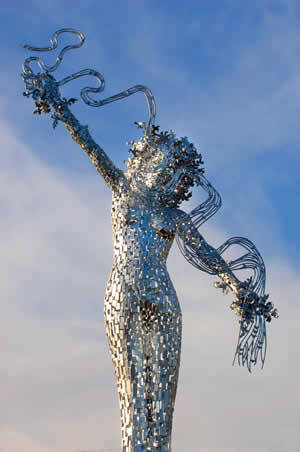
AIR SPIRIT / STRIDE
The second sculpture was built at Muirside roundabout in Tullibody February 2008.
It is a sculpture of a man striding forward towards Ochil Hills, and it is a partner piece to River Spirit (above).
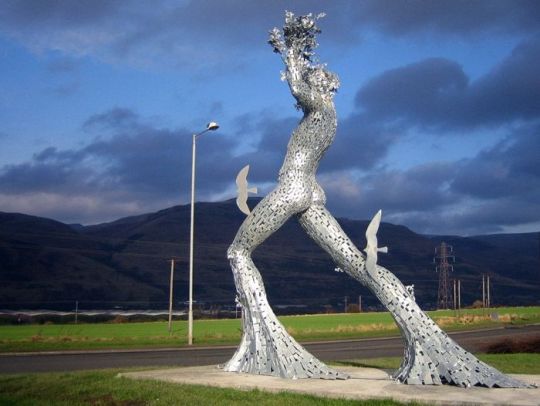
I CAN SEE FOR MILES
The third sculpture represents Alloa's regeneration and was installed on Station Square before the Stirling - Alloa - Kincardine Railway opening in May, 2008.
It shows a child representing the future and an adult showing the working industry of the area, wearing a flat cap.
The young person appears to rise from the industrial past and faces forwards towards the town.
Scott got local input on this project and he received design ideas from St Mungo's and St Serf's primary schools and Bowmar Community House. The project got a lot of support from Alloa Rotary Club.
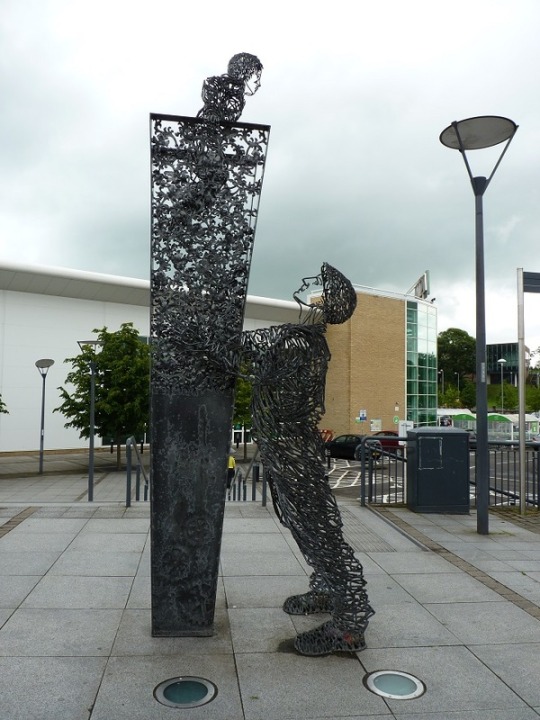
FOX BOY
Fox Boy is a sculpture of a boy with a fox head sitting on top of a water wheel. It was installed in 2008 in Menstrie Midtown Gardens.
The boy is dressed in current, modern day clothes but the foxes head represents both the foxes that live in the countryside and the past days when children in the village kept foxes as pets!
There is a buzzard which represents the pair that live in the woods.
The maple leaf under the boys had represents Menstries connection with Nova Scotia.
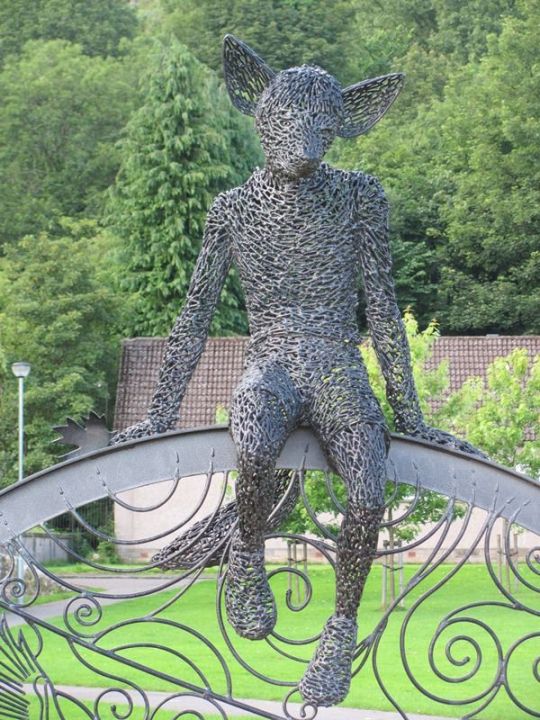
THE JOURNEYS END
The Journeys End sculpture was installed on Marywood roundabout on the outskirts of Clackmannanshire in August 2009. It took 9 months to make, is over 7 meters tall and weighs almost a tonne and a half.
It welcomes drivers as they enter the county.
Andy's brief was to create a sculpture to signal the start of Clackmannanshire from the New Bridge Connection, celebrating the new crossing.
The two figures stand on top of two halves of a steel arch and reach towards each other and make the connection.
The male carries a crown with his other arm from Clackmannanshire heraldic coat of arms. The female holds a circle of 23 stars representing the European Union's flag showing Clackmannanshire welcoming Europe and visitors from the east of the new bridge.
The sculpture frames the road beyond the roundabout leading to the county.
The figures have foliage hands and hair referencing the natural environment as shown in other sculptures.
It is made of galvanized steel in a steel mosaic technique giving it a similar appearance to the others while maintaining its unique identity marking the entrance to the area.
Andy said "In keeping with most of my works, there is an immediacy of recognition in the artwork - the public can see what it's meant to be straight away. Whether they 'get' my intended symbolism or not is part of the art - it's great if they do, but I also hope that they invent their own mythology and there is a sense of engagement and curiosity".
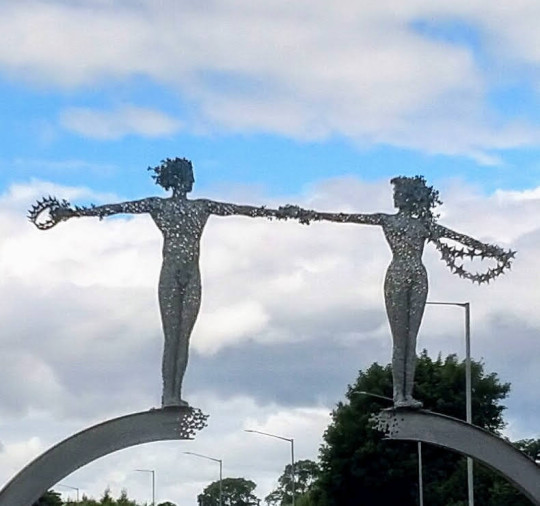
LIFELINE
This sculpture was made as a tribute to the emergency services!
The large hand comes from the gauntlets which appear on the heraldic coat of arms for Clackmannanshire.
The abstract and angular style mirrors the uniforms and machinery connected to the military and emergency services. It uplifts the mother and child portraying the support those services provide.
The Mother reaches upwards while using the hand for support and the child reaches forward while holding onto the mother. Ether offering or asking for help depending on your interpretation.
While untied to any specific religion, the stars are a nod to religion in general.
If you look closely the child has winged feet which references Hermes, the protector of travellers.
The sculpture itself is placed in Shillinghill roundabout in Alloa, a busy junction. It was installed in May 2011.
Jim Carruth's words fro his short poem 'Lifeline' has been laser cut and welded to the sculpture;
'Life-line Reach Out, Hold, Close, Cradle, Cushion, Shelter, Protect, Support, Lift Up’.
It took Andy a year to create in his workshop.
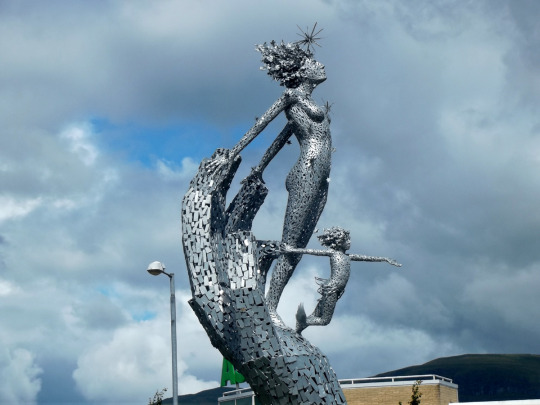
Sorce: https://www.clacks.gov.uk/culture/journeysend/
0 notes
Text
Edinburgh - Thursday
Today's title is a bit of a misnomer because we spent most of our time either in Glasgow or getting there or getting back. If you remember, we were meeting with Fr. Eamon.
Carol had arranged for a taxi to pick us up at 8:45 because the taxi dispatcher wanted to make sure she took into account rush hour. When we got there we had to print out our tickets, and had a bit of a problem until Carol realized that she hadn't paid for the tickets, Sharon had provided her credit card. Once that was sorted, everything went very smoothly and the machine printed out the tickets.
We had bought return (we say round-trip) tickets and also "any time" tickets, meaning we could take any train to get there and any train to return. We did that because we were not sure what time we would be finished with our visit with Fr. Eamon. But we had agreed to take the 10:15 train from Waverley Station to Glasgow Queen's Street Station. Glasgow also has a Central Station.
An interesting thing is that they didn't post the platform until 7 minutes before the train was scheduled to depart. Most of the platforms are in one area, but there are several platforms that require a bit of walking; I don't know what those people would do.
The station is named after one of Sir Walter Scott's novels, and throughout the station they have posted quotes from Scott's work.
We noticed a pigeon boldly walking about, not afraid of people. Is someone came close, it just calmly moved away. When I took his picture, he seemed to stop and pose.
Carol and I had to use the facilities, and much to our surprise, we had to have 30p in exact change. A woman saw us looking at our change and took pity on me and gave me the extra 10p I needed. I was so flabbergasted at having to pay for the loo, that I didn't even thank the woman, nor did I ask her if she had another 10p for Carol. Carol graciously said she'd would use the train's facilities. By the time I was on my way out, I had recovered use of my meager faculties and so I went to a Burger King and asked for change; I must have looked so pitiful that the manager, after telling me that he wasn't supposed to do this, did give me change. I was then able to give the needed change to Carol. Phew!
Finally the platform was announced and off we went to go through the turnstiles. What you do is insert your ticket in a slot in the front of the machine; the machine reads it and authenticates it, and then spits it back out the top. You grab it and the little gates open up and let you pass. I had no problem getting through, but Carol and Sharon had to have help, we don't know why.
The train arrived and we got in, found a seat for four and we were off. The ride takes about 50 minutes, and sure enough, we got there in just that time. The way to exit from the platform to the main part of the station is the same way we entered. That is, you put your ticket into the front slot, but this time it keeps it and you can go through. It's an interesting system.
Out on the main foyer we stood around for a little while; it was where we had agreed to meet with Fr. Eamon and after a couple of minutes there he was. Carol and I didn't know him, but Sharon did so she spotted him right away. Introductions were made all around, and we left the station and went around the corner, where he queued up to get on a Glasgow Hop-On Hop-Off bus. We were doing the full circuit for a total of 1 hour and 20 minutes. So the four us got on the second bus because it had live commentary rather than just an audio guide, and from experience in Edinburgh, we felt the live commentary was much more interesting and timely.
The buses leave from and return to George Square, a very lovely plaza. Hanging from poles around the square were advertisings for The World Badminton Championship, taking place from August 21-27. Wonder who will win.
The tour guide was a lively, artsy guy who obviously loved to sing as we were serenaded several times throghout the tour, and it was clear he had a lot of knowledge about the various sites, and also about the night life and entertainment available in the city. He was also not afraid to give his opinion about various issues.
I was seated by the left windows of the bus, so there were several locations I couldn't take pictures of because they were on the right side, and the bus itself got in the way of the picture. But I did manage to capture most locations. Okay, here we go.
Saint Mungo lived from 528 to 614 and he is the patron saint and founder of Glasgow. There are a lot of murals in Glasgow and Sam Bates (called Smug) is one of the best know ones. He painted a portrait of Saint Mungo as a contemporary person that is very beautiful.
Glasgow Cathedral is the oldest building in Glasgow, having been built in 1197, which makes it a medieval structure.
There is a Royal Doulton fountain at the People's Palace in Glasgow Green that has a life size sculpture of Queen Victoria, but she was so petite (in her youth) that it hardly seems to be life size. It was unveiled in 1888 to commemorate Queen Victoria's Golden Jubilee.
The People's Palace contains historical artifacts and various media to tell the story of Glasgow and its people from 1750 to the end of the 20th C.
There is an obelisk that is a tribute to Lord Nelson.
Stan Laurel started a career at age 16 doing a performance at the Britannia Panopticon Theatre and everything he did went wrong, but he had the audience rolling on the aisles, so he decided to do it intentionally, and went to America where he met a partner to do it with.
We passed The Scotia, the oldest bar in Scotland, and reputed to be haunted by a multitude of ghosts, some of which appear to applaud some performers.
The Style Mile is the high-end shopping area in Glasgow, with all the exclusive (read expensive) stores being represented.
We passed a statue of the Duke of Wellington in front of GAMO, the Gallery of Modern Art. If you look closely you'll see that both the Duke and the horse he rode in on both have a traffic cone on their heads. Apparently some university types did this and the council took them off, then the uni guys did it again, and the council...etc. After a while the council saw the error of its ways and let it stand.
This was not on the tour but we passed a building I really loved, the Union Stree Co-op, so here it is.
The tour guide told us that while Gaelic is spelled the same by the Irish and the Scots, the Irish pronounce it GAY-lic, whereas the Scots pronounce it GAL-ic. The Irish also refer to Gaelic as just Irish, whereas the Scots do not call it Scottish.
The river Clyde runs through Glasgow; it's a tidal estuary, which means that the water reverses direction with the tide. There is an 11 ft difference between the level at high and low tides. There used to be 50 steam ferries that plied the Clyde (I'm a poet and didn't know it). There used to be no bridges because there were 17 shipbuilders on the Clyde, who employed around 17,000 people, and the ships that were built could not have been sailed to their destination if there were bridges to impede passage. Now there is only one shipbuilder left.
Now there is one very modern bridge over the Clyde (I believe there may be other bridges), that is officially called the Clyde Arc, but is called by locals by the name "squinty bridge," referring apparently to the fact that the bridge is at an angle.
The Glasgow Tower is a free-standing tower on the south bank of the River Clyde, and it holds a Guinness World Record for the tallest tower in the world which can rotate 360 degrees. It has been closed for more than 80% of its life. It reopened in 2014. It is part of the Glasgow Science Center.
A quote from our guide, Peter: "the only difference between summer and winter in Glasgow is the temperature of the rain."
The Hydro is a concert venue. The Armadillo (formerly called the Clyde Auditorium) is also a concert venue and vaguely looks like the Sydney Opera House. There's a third one called the SEC Centre.
Not on the tour was a multicolored building that looked interesting. However, they were just renovating the building, but I still liked the look.
Also on the Clyde was the Glen Lee, the last sailing ship built in the Clyde shipyards, in 1895. Glasgow rescued it from its being used as a training ship by Spain's navy, and refurbished it and brought it to this location as an attraction that showed what was being done in the old Clyde shipyards.
There is a spot where to rivers meet, it's easy to see in my photos because I have a pole that bisects the picture. They are the Clyde and the Kelvin.
Again, not on the tour, I saw the façade of a building that just looked so interesting. I had to shoot it through the right window, so I only got a piece of it.
The Kelvingrove Art Gallery and Museum was made to look like the church of Santiago de Compostela, the end of the old Pilgrimage Trail in Spain. It's absolutely beautiful, like so many of the buildings on this tour, and one of the more surprising things about Glasgow.
We passed a bridge over a stream that had nice sculptures on each end and I couldn't resist.
Another amazing building the University of Glasgow that looks gorgeous from all sides.
The Kelvingrove Museum again, and a strange green mascot or something. Followed by another view of Glasgow Uni.
Not on the tour a lovely clock tower in the middle of nothing.
The word Sauchy (pronounced "sucky") is in this bar's name and is also part of the street name.
The Royal Conservatory of Scotland. A poster for A Streetcar Named Desire. Pretty flowers.
Pictures of Fr. Eamon and us. Oh, I forgot to mention that Fr. Eamon took us all out to lunch after the tour bus, to this place, which had great food. And he insisted on treating us, even though we had wanted to pay for it. He'll get copies of these pictures.
And finally, back to St George Square, the Glasgow Train Station, and the mural of Saint Munro.
That's it. I'm sorry you can't see the pictures yet, but I promise I'm working on them.
0 notes
Text

heheheheeeeeeeeee
#zero escape#zero escape 999#9 hours 9 persons 9 doors#ze 999#zero escape june#zero escape akane#akane kurashiki#zero escape junpei#junpei tenmyouji#flipline studios#sauchi art
113 notes
·
View notes
Text

🍀
Close up below!!!

#zero escape#9 hours 9 persons 9 doors#ze 999#clover field#zero escape clover#zero escape 999#sauchi art
106 notes
·
View notes
Text

an old practice from months ago... (original reference below)

#harvey sdv#sdv harvey#stardew fanart#stardew valley harvey#stardew harvey#harvey stardew valley#stardew valley fanart#sdv#sdv fanart#sauchi art
115 notes
·
View notes
Text

🐇Thank you... Thank you so much Jumpy... 🐇


#zero escape#zero escape 999#9 hours 9 persons 9 doors#nine hours nine persons nine doors#zero escape akane#akane kurashiki#zero escape akane kurashiki#zero escape spoilers#999 spoilers#sauchi art
99 notes
·
View notes
Text

silly kanny to keep the sadness away :3
#zero escape#zero escape akane#zero escape akane kurashiki#akane kurashiki#akane kurashiki fanart#zero escape fanart#zero escape 999#ze 999#9 hours 9 persons 9 doors#nine hours nine persons nine doors#sauchi art
57 notes
·
View notes
Text

Chibi ZTD junepei before I forget how to paint digitally
hiiii btw
#zero escape#zero time dilemma#zero escape ztd#ztd#ztd spoilers#akane kurashiki#junpei tenmyouji#junepei#ztd fanart#sauchi art
46 notes
·
View notes
Text

really late for ainiversary but weelll
#aini#tama aitsf#kuruto ryuki#ai the somniun files nirvana initiative#ai the somnium files#ai the somnium files fanart#aitsf#sauchi art
61 notes
·
View notes
Text

HBD DATEEE!!!!!!!!!111 🗣️🗣️🗣️🗣️
#ai the somnium files#ai the somnium files fanart#ai the somniun files nirvana initiative#ai the somnium files date#kaname date#kaname date fanart#aitsf fanart#ai the somnium files aiba#aiba#aiba aitsf#aiba fanart#aini fanart#sauchi art
40 notes
·
View notes
Text

HBD MIZUKI!!!!!
#aini#aitsf#ai the somnium files#ai the somniun files nirvana initiative#mizuki date#mizuki okiura#aini fanart#ai the somnium files fanart#sauchi art
43 notes
·
View notes
Text

ParanoIA
#ai the somnium files fanart#ai the somnium files#aitsf#aitsf fanart#ai the somnium files iris#iris sagan#aitsf iris#sauchi art
20 notes
·
View notes
Text

acting very normal while drawing them, so normal...... (maybe doin' a keychain for myself with this drawing???)
#zero escape#zero escape 999#9 hours 9 persons 9 doors#zero escape akane kurashiki#zero escape akane#zero escape junpei#junepei#junpei tenmyouji#akane kurashiki#sauchi art
16 notes
·
View notes